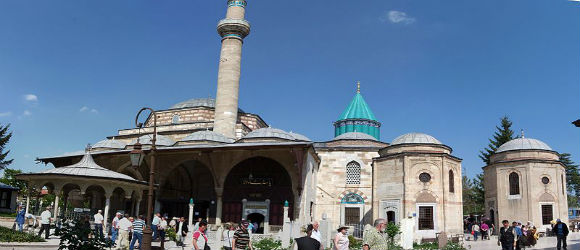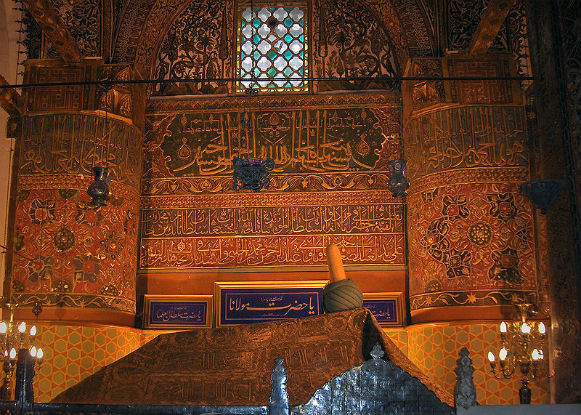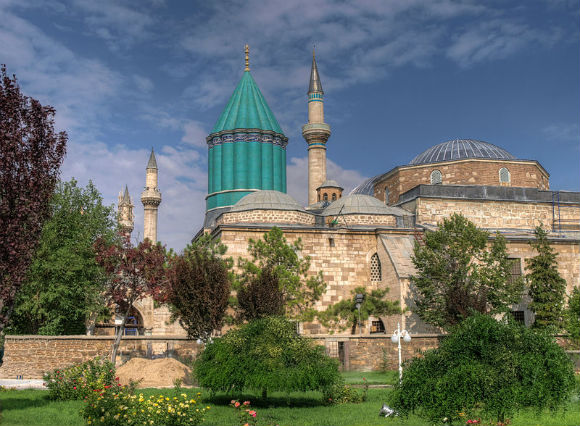The Mevlana Museum also known as the Green Mausoleum or Green Dome, is the original lodge of the Mevlevi Whirling Dervishes, a mystical Sufi Muslim group. It containes the tomb and shrine of the Mevlana, or Rumi, which remains an important place of pilgrimage.
History
Sultan ‘Ala’ al-Din Kayqubad, the Seljuk sultan who had invited Mevlana to Konya, offered his rose garden as a fitting place to bury Baha’ ud-Din Walad (or Bahaeddin Veled), the father of Mevlana, when he died in 1231. When Mevlana himself died on December 17, 1273, he was buried next to his father.
Mevlana’s successor Hüsamettin Çelebi built a mausoleum (Kubbe-i-Hadra) over the grave of his master. The Seljuk construction, under architect Behrettin Tebrizli, was finished in 1274. Gürcü Hatun, the wife of the Seljuk Emir Suleyman Pervane, and Emir Alameddin Kayser funded the construction.
The cylindrical drum of the of the dome originally rested on four pillars. The conical dome is covered with turquoise faience. Several sections were added until 1854. Selim I decorated the interior and performed the woodcarving of the catafalques.
A decree by Ataturk in September 1925 dissolved all Sufi brotherhoods in Turkey. On April 6, 1926, another decree ordered that the Mevlana mausoleum and dervish lodge be turned into a museum. The museum opened on March 2, 1927.
Special permission granted by the Turkish government in 1954 allowed the Mawlawi dervishes of Konya to perform their ritual dances for tourists for two weeks each year. Despite government opposition the order has continued to exist in Turkey as a religious body. The tomb of Rumi, although officially part of a museum, attracts a steady stream of pilgrims.
What to See
The dervish lodge (tekke) includes a semahane, where the ritual sema or whirling ceremony takes place, a sadirvan for ritual ablutions, a library, living and teaching quarters, and the mausoleum housing the tomb of Celaleddin Rumi, founder of the sect and later awarded the honorable title of Mevlana. His epitaph reads: “Do not seek our tombs on this earth – our tombs are in the hearts of the enlightened.”
The mausoleum room is highly ornamented with Islamic script and enameled reliefs, and contains the tombs of several of the more important figures of the dervish order. The main tomb enclosed behind a silver gate crafted in 1597 is that of Mevlana. The tomb of his father, Bahaeddin Veled, is upright and adjacent to his son’s, a position that signifies respect.
The adjoining room, or the semihane, is now a museum of Mevlana memorabilia displaying musical instruments and robes belonging to Mevlana, along with Selçuk and Ottoman objects like gold-engraved Korans from the 13th century. Among the fabulous ancient prayer rugs is the most valuable silk carpet in the world.
Mevlana Museum, Konya,




Mevlana Museum, right in the center of the charming city of Konya, in Turkey, attracts a lot of tourists, maybe all tourists that happen to visit to Konya. As a former mosque, it is also a holy place, and Mevlana followers still visit and pray there. Besides the building's very beautiful architectural caractheristics and its ancient relics, what I found…
Interesting place – mostly for watching the reverence the local people gave to the shrines. The shrines themselves are fine with some interesting carpets on show.There are a set of rooms round the outside that give a good insight into the dervishes.
The Mevlana is a must-do if you visit Konya. It's only 3TL to get in, which is practically nothing, and it's money well spent. You go through all these passageways and learn about the dervishes' training, and the unique practice of Islam that this region has produced. There are also several good restaurants in the immediate vicinity, many of which…
We arrived at our hotel mid afternoon and our tour guide suggested that we might like to visit the museum which was close by.
A former mosque this became a museum dedicated to the Whirling Dervishes . On three sides of the courtyard housing is provided for the Dervishes and the displays in each room are excellent.
We were lucky…
Did it twice; once without audio tour/guide/or any research and then once with. If you're going to visit, read Rumi's biography, take the audio tour, or pay a tour guide/someone who can explain the history, or do some research to give the place context, otherwise it's a bunch of old stuff to look at with minimal written descriptions of things….
It was quite interesting to visit. There were lots of different rooms to go into with various items inside.
If you have the possability to visit Konya you need to go to the mevlana Museum. History is interesting about this sect he founded. you can see the refuge, his books, his grave and even kiss the montre with muhammeds beard (or so they say).
My guess is that Konya can be done on a tour passing through the city…
If you're in Konya to see the Whirling Dervishes (and who isn't?) you cannot miss this museum/temple/tomb. Entry is a bargain at 3 TRY, although you definitely need the audio guide (10 TRY, don't forget an ID or something as a deposit).
There are roughly three sections – the gardens (obviously quite sparse and miserable in winter, but would be…
A feel of Rumi's living place. The food and shows are pleasing. It is time to meet many poeple who are here to connect through Poem's of Rumi.
This place attracts a lot of local tourists as well as international tourist as the building has a beautiful fluted turquoise dome. It has the Karatay Medrese and Ince Minaret.